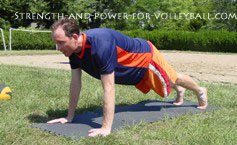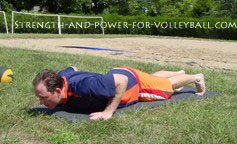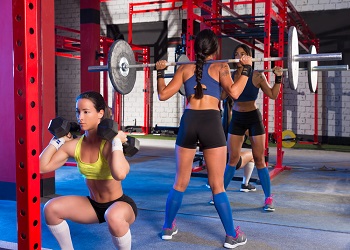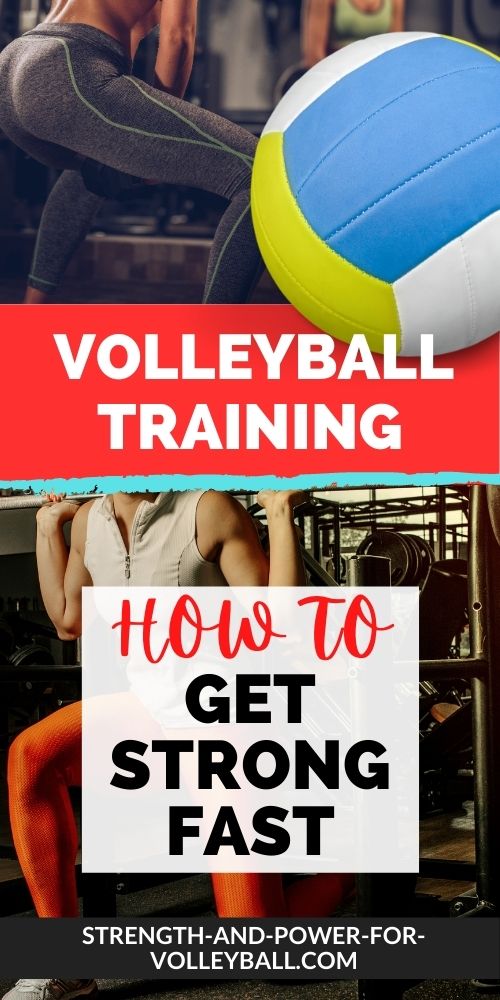- Home
- workout for volleyball
- volleyball workouts
Volleyball Workouts
Multi-joint Exercises for Volleyball
Volleyball workouts should consist of both upper and lower body multi-joint exercises.
Multi-joint exercises should be a central focus of your workouts because...
- Multi-joint exercises train coordination and movement strength your body needs, not only in athletics but every day life.
- Multi-joint movements are more efficient than single joint movements because you are training larger muscle groups which results in more work done per repetition.
- By training multi-joint movements, you are developing a base for building strength and explosive power.
- Because multi-joint exercises are often performed in a slow controlled manner, the likelihood for injury is much less.
Front and Back Squats
Lower Body Exercises for Your Volleyball Workouts
Lower body multi-joint movements train the large muscle groups
- Quadriceps (front of the thigh)
- Hamstrings (back of the thigh)
- Gluteals (the buttocks)
Your volleyball workouts should have an appropriate balance of upper and lower body exercises because...
- Many lower body multi-joint exercises such as the squat require sufficient total body strength in order to perform the movements correctly.
Squats can be performed in many variations in volleyball workouts. You can place the barbell across your shoulders (back squat). You can squat with the bar placed in front of your shoulders (front squat).
You can also do more functional variations such as double and single leg dumbbell squats. Each exercise trains the entire leg and hip area and is unique in the way it applies resistance to the body.
If you enjoyed these tips and would like to keep it close to you at any time, just save this pin to your Pinterest Volleyball Training Board.
-
Back Squat
Squatting should be the cornerstone of your volleyball strength training.
Purpose:
Volleyball workouts should include squat variations because of its direct application to jumping performance.
Starting Position:
Place the bar on the upper back and shoulders in a balanced position.
Hold your chest up and out.
Push your shoulder blades together.
Signal the spotter you are ready to move the bar off the rack.
Extend the hips and knees to lift the bar.
Take one or two steps backward.
Place the feet shoulder width or slightly wider apart.
Action:
Downward movement - Keep the torso to floor angle constant as you slowly flex the hips and knees to lower the bar.
Maintain a flat back, with elbows high, and chest up and out.
Keep the heels on the floor and knees aligned with the feet.
Do not flex the torso or round the back.
Continue flexing the hips and knees until the thighs are parallel to the floor.
Do not relax the torso at the bottom of the movement.
Upward movement - Extend the hips and knees at the same rate.
Maintain a flat back, with elbows high, and chest up and out.
Keep the heels on the floor and knees aligned with the feet.
Continue extending the hips and knees to reach the beginning position.
After the set is complete, step forward and rack the bar. -
Split Squat
The split squat is similar to the lunge. Both are extremely sport specific and great for strengthening your legs and hips dynamically.
Purpose:
A great exercise to include in your volleyball workouts for increasing balance and strength in your hip and leg muscles.
Starting Position:
Set a bar across your shoulders or hold dumbbells at arms length at your sides. Step forward with your lead leg to a lunge distance.
Action:
Lower your hips by squatting back and down. Without letting the back knee touch the ground, return back up by pushing through the heel of your front leg while keeping the front foot flat on the ground.
Coaching cues:
The front foot should be placed so that when you reach the bottom of the movement, your front knee is directly above your front ankle. If your knee ends in front of or behind your ankle, adjust your foot placement accordingly. Your torso should stay erect throughout the movement. -
Physioball leg curl
A functional exercise for training the hamstrings and glutes.
Purpose:
Performing leg curls on a physioball in order to use the hamstrings and glutes as hip extensors.
Starting Position:
Lie face up on the floor with your heels on the balance ball and your arms flat on floor. Pull your toes up toward your shins and push your shoulder blades back and down. Fire your glutes to raise your body up and form a straight line from your ankles to your shoulders.
Action:
Pull your heels toward your glutes, flexing your knees and rolling the ball onto the bottom of your feet. Extend your knees back to the starting position.
Coaching cues:
Keep your glutes fired with the hips extended (straight line from knees to shoulders) the entire time you are performing the exercise. -
Step Up
Step ups put less stress on both the knees and low back. You can vary the height of the step platform and also the distance you step to the platform to work different muscle groups.
Purpose:
The step up can be a good alternative for volleyball players with hip or knee problems. Step ups can be a good introductory exercise for single leg strength training.
Starting Position:
Set a bar across your shoulders or hold dumbbells at arms length at your sides. Stand in front of a box or step platform.
Action:
Place your entire lead foot onto the box and push down through the heel and midfoot to raise your body up to the box. Forcefully extend the lead hip and knee to move your body to a standing position on the box.
Coaching cues:
Leave the trailing foot in position until you have placed your front foot on the box. Do not push off the trailing leg when stepping up onto the box, only use the front leg.
Upper Body Exercises for Your Volleyball Workouts
Push ups that challenge shoulder stability are great for volleyball players.

One Arm Medicine Ball Push Ups Challenge Shoulder/Core Strength
Since body weight is used as resistance, many untrained athletes may find push ups difficult.
However, the technique for the push up can be altered using less than full body weight. Make push ups easier by placing the hands in an elevated position such as on a bench.
My Favorite Medicine Ball for Training
Also, push ups done on the knees is easier.
Push Up
The push up is a common upper body multi-joint exercise for working the chest and triceps. Push ups are an important exercise
for strengthening the shoulders, particularly shoulder stability for
hitting volleyballs. Also, because there is no need for equipment, push
ups are a convenient exercise for volleyball workouts.
-
Purpose:
To build upper body strength in the chest, upper arms, and shoulders. -
Starting Position:
Lie face down on the floor. Lift your body up off the ground by using your hands and toes to support your body weight. Straighten your arms and brace your core so there is a straight line from your head to your heels. -
Action:
Flex your elbows to lower your body. Touch your chest to the ground then return to the starting position by straightening your arms. -
Coaching cues:
Keep your core braced and back straight throughout the movement.


-
Vertical Pull Up
Pull ups train the lats, upper back, shoulder, and front of the upper arm. Volleyball workouts should include pull ups to develop upper body functional strength, important for athletes that perform overhead throwing type motions.
Purpose:
Strengthening the upper body, back and shoulders.
Starting Position:
Grab a pull up bar shoulder width apart with an overhand grip. Hang from the bar in a fully extended position.
Action:
Pull your shoulder blades back and down to lift your body up. Finish by pulling with your arms. Return to a fully extended position.
Coaching cues:
Exercise in a full range of motion by bringing your chin up above the bar at the top of the movement and fully extend your arms at the bottom of the movement. You can adjust the hand position for a different training effect. -
Horizontal Pull Ups
The horizontal pull up is the opposite of the bench press and primarily works the muscles around the scapula that are involved in pulling movements. This is a safer alternative to performing rows from a bent over position. Horizontal pulls can be used effectively in volleyball workouts for working the area around the scapulae that's important for shoulder strength.
Purpose:
To develop upper back strength around the shoulders.
Starting Position:
Place your heels up on a bench and grip the bar as if you were to perform a bench press. Your body should be hanging in the air with your arms straight, hands grasping the bar about shoulder width and feet propped up on a bench or box.
Action:
While keeping your body straight, pull your chest up to the bar.
Coaching cues:
Brace your core to help keep your back flat throughout the movement.
Because of the large muscle groups that are worked, you should maximize
your training time by performing multi-joint exercises in your
volleyball workouts.
Multi-joint Volleyball Workouts Related Pages
Total Body Volleyball Strength Training
Functional Strength Training Volleyball Workouts
